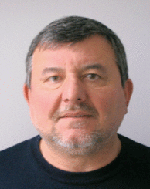 |
|
Biography
Mihail Nedjalkov, born in Sofia, Bulgaria received the Master degree in semiconductor physics at the Sofia University "Kl. Ohridski", a Ph.D. degree (1990), Habilitation (2001) and D.Sc. degree (2011) at the Bulgarian Academy of Sciences (BAS). He is Associate Professor with the Institute of Information and Communication Technologies, BAS, but held visiting research positions at the University of Modena (1994), University of Frankfurt (1998), Arizona State University (2004) and mainly at the Institute for Microelectronics, TU-Vienna, supported by the following European and Austrian projects: EC Project NANOTCAD (2000-03), "Osterreichische Forschungsgemeinschaft" MOEL 239 and 173 (2007-08), FWF (Austrian Science Fund) P-13333-TEC (1998-99), START (2005-06), P-21685 (2009-2014), EC-FP7 Project SUPERTHEME and the current H2020 Project SUPERAID7. He has served as a lecturer at the 2004 International School of Physics "Enrico Fermi", Varenna, Italy, and has over 160 publications. His research interests include physics and modeling of classical and quantum carrier transport in semiconductor materials, devices and nanostructures, collective phenomena, theory and application of stochastic methods.
The Role of Confinement in Carrier Transport
Aggressively scaled "More Moore" devices, such as FDSOI, FinFETs, and nanowire transistors, are designed around the concept of spatial confinement, which challenges existing notions of electron transport, originally derived under the assumption of a bulk crystal. Scattering mechanisms are characterized by the fundamental rules of the conservation of energy and momentum, derived from the properties of an electron in the bulk, i.e. a well-defined three dimensional (3D) momentum and a continuous energy spectrum.
In confined structures, e.g. nanowires, there is a single (1D) transport direction. The transverse plane of confinement is characterized by a quantization of energy, forming subbands, and a lack of a well-defined momentum in accordance with the uncertainty relations. Thereby, both the scattering rates and the kinetic characteristics are heavily modified. Fermi's golden rule gives rise to energy conservation which explicitly involves the transverse subband energies. The momentum conservation rule becomes 1D: The electron momentum after scattering is changed by absorbing or emitting a phonon with a momentum along the transport direction.
The usual process of scattering occurring in 3D momentum space is now characterized by a transition between two energy subbands and two 1D momenta. The eigenfunctions of the scattering subbands that are involved need to be included in the matrix elements determining the scattering rates. The evaluation of the latter is much more computationally demanding as compared to its bulk counterpart, where analytic expressions for the scattering rates can usually be obtained.
A complete set of multi-subband scattering mechanisms for the most relevant semiconductors, including Si, SiGe, Ge and III-V materials, taking into account the confinement-induced effects on electron momentum, energy, and kinetic characteristics, are derived from first principle considerations. These include interactions with acoustic and deformation potential optical and polar optical phonons, as well as alloy and impurity scattering.



